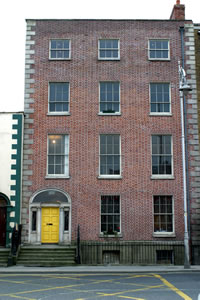Culture Night at 15 Usher’s Island
Sep 28th, 2009 by Jim Kennedy
Friday night was Culture Night here in Dublin, and elsewhere too I suppose, but you’ll forgive the Dublin-centric focus here at Dublin Opinion. Culture Night essentially seems to be a night when all the cultural places you’ve meant to visit recently are open late in the evening one night in the year, and all for free too. A brilliant idea really - go to Dublin Castle, the National Gallery, whatever, late into the evening. In a city where ‘culture’ can seem almost exclusively tied up with going for drinks, it’s a refreshing idea. We’re all Europeans now you know, at least for another week. How about opening everything up in the evenings once a month, instead of annually?
Like most Dublin residents, I’ve a list of places I’ve passed by a million times meaning to visit but never getting around to, partly I suppose because of the familiarity of the local, and the certainty that it’ll always be there and I’ll get around to it someday. I’ve gone out of my way to see Rodin’s house in Paris, but would I go up to the South Circular Road to see George Bernard Shaw’s gaff? No, but sure I’ll get around to it one of these fine days.
A recent conversation on James Joyce’s The Dead, the closing short story of the Dubliners collection, prompted me to spend Culture Night at the James Joyce House Museum, at 15 Usher’s Island, down the quays. The house is the setting for the story, and it’s currently being restored to look as it would have in 1904, when the story set and when it belonged to Joyce’s great-aunt.

The key moment of the story is as the party breaks up (if you haven’t read it already - shame on you, and ’spoiler alert’). Gabriel Conroy is standing at the foot of the stairs looking up at his wife. She is transfixed just below the return, pausing in her descent as a familiar song cascades down from the upper floors from the visiting tenor Mr. Bartell D’Arcy who, at the behest of his hosts, is closing out a largely successful dinner party. Gretta Conroy pauses on the stairs, delaying her leave-taking - always the sign of a good party, when you don’t really want to leave. The song is an old tragic story of a spurned, fallen women pleading for redemption for the sake of her child. Gretta doesn’t remember the name of the song - the melancholic The Lass of Aughrim - but it carries her back to an almost forgotten life of youth and love, reminding her of her dead love.
Lost in the past, she is unaware of how her husband at the foot of the stairs is seeing ‘just’ her beauty and his own good fortune. Only later, when he queries her about the song will he become aware that although he knows her, there’s always a part of this woman that will forever be a mystery to him. In this way, despite his conceits, he is Everyman. As the song finishes, they both return - she to the stolid present, and he to one shortly to be beset by doubts. They leave the house and take a carriage to the Gresham Hotel where he, perhaps against his better judgment, presses her on her past. That she tells him of her lost love changes nothing for her, but will surely shatter his complacent, successful world, knowing that ultimately there’s a part of his wife’s heart that will never be his.
Forgive the personal spin on the plot precise, but Joyce’s The Dead is widely regarded the finest short story ever committed to paper, and everyone will ‘read’ it differently. For me, it’s the perfect piece of art - complete in itself and open to showing anything you want to see in it - and I make a point of revisiting it each year. The hallway and the stairs are so familiar when you walk in - the makers of the film based on the story obviously made a huge effort to reproduce the setting in great detail. You feel that you don’t want to go up the stairs, it’s sufficient to stand where the fictional Gabriel Conroy stood, and where James Joyce himself must surely have stood as a child.
After living in Dublin half my life, it took a late-night opening before I took the opportunity to visit. In Joyce’s time, the house belonged to his great-aunt and the setting of the story - an annual Little Christmas dinner party - was a childhood memory for him. These days, the four-story over-basement Georgian house on the way out of town on the quays, right at the southern side of the Calatrava Bridge, is a restoration project - apparently the passion of one man who saved it from dereliction and near-demolition in the bad old days of Dublin’s modernity drive. The culture night event saw the house open to all comers until well past the advertised time of 10 PM, with one room laid out for a supper sitting, as per the story. In another room there was a silent projection of the John Huston film - in my opinion a beautiful and faithful rendering of the story - playing throughout the evening. I almost laughed out loud when I saw a guy with a strong likeness to the film’s version of the Freddie Malin character (the cheerful drunk who’s a burden and an embarrassment to his poor mother) walking around. I assumed he was an actor, but it turned out he was another visitor like myself. I almost laughed, but I didn’t as you can’t really be doing that. The house was lit throughout with little penny candles in glasses - in the rooms, on the stairs, in the windows overlooking the Liffey - giving it that warm and welcoming feel appropriate to the convivial dinner party experience with which the house is associated.
At several points in the evening (I spent an hour wandering around) people were invited to tell old stories or to sing. One woman, whose name I didn’t catch, sang The Lass of Aughrim and the host joked that we should all be on the landing listening, heads crooked, but there wouldn’t be room for us all. It’s funny how it can take you an age to get around to making a pilgrimage in your own city, but when you do, it can be perfect.




Great post Jim - apologies that I’m the first to comment on it. Sounds like the Nuits blanches they have over here (well up in Paris) every year.. Come to think of it, I think Dublin always had a Culchie night - every Friday - when many’s the student and humble civil servant was to be seen on their way to converted bingo buses that’d take them home for the weekend laden down with a few tons of dirty laundry - does that still exist ??
Love Huston’s last film - always thought it’d be the perfect one to watch on a Bloomsday too. I don’t think anyone else ever came within a country mile in terms of adapting Joyce to the big screen. Glad to hear the house is almost presentable again - remember it as being in a sad state when I last lived in Dublin - over a decade ago.